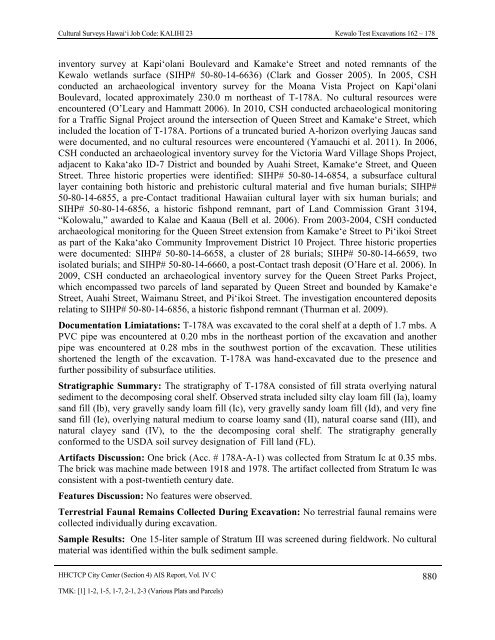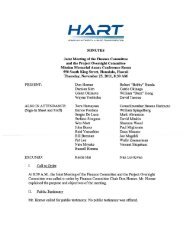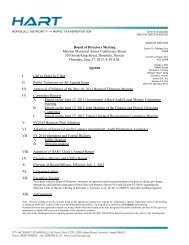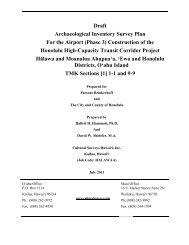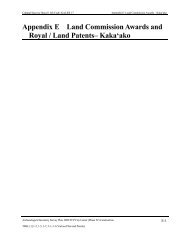4.12 Test Excavation 167 (T-167) - Honolulu Rail Transit Project
4.12 Test Excavation 167 (T-167) - Honolulu Rail Transit Project
4.12 Test Excavation 167 (T-167) - Honolulu Rail Transit Project
You also want an ePaper? Increase the reach of your titles
YUMPU automatically turns print PDFs into web optimized ePapers that Google loves.
Cultural Surveys Hawai‘i Job Code: KALIHI 23 Kewalo <strong>Test</strong> <strong>Excavation</strong>s 162 – 178inventory survey at Kapi‘olani Boulevard and Kamake‘e Street and noted remnants of theKewalo wetlands surface (SIHP# 50-80-14-6636) (Clark and Gosser 2005). In 2005, CSHconducted an archaeological inventory survey for the Moana Vista <strong>Project</strong> on Kapi‘olaniBoulevard, located approximately 230.0 m northeast of T-178A. No cultural resources wereencountered (O’Leary and Hammatt 2006). In 2010, CSH conducted archaeological monitoringfor a Traffic Signal <strong>Project</strong> around the intersection of Queen Street and Kamake‘e Street, whichincluded the location of T-178A. Portions of a truncated buried A-horizon overlying Jaucas sandwere documented, and no cultural resources were encountered (Yamauchi et al. 2011). In 2006,CSH conducted an archaeological inventory survey for the Victoria Ward Village Shops <strong>Project</strong>,adjacent to Kaka‘ako ID-7 District and bounded by Auahi Street, Kamake‘e Street, and QueenStreet. Three historic properties were identified: SIHP# 50-80-14-6854, a subsurface culturallayer containing both historic and prehistoric cultural material and five human burials; SIHP#50-80-14-6855, a pre-Contact traditional Hawaiian cultural layer with six human burials; andSIHP# 50-80-14-6856, a historic fishpond remnant, part of Land Commission Grant 3194,“Kolowalu,” awarded to Kalae and Kaaua (Bell et al. 2006). From 2003-2004, CSH conductedarchaeological monitoring for the Queen Street extension from Kamake‘e Street to Pi‘ikoi Streetas part of the Kaka‘ako Community Improvement District 10 <strong>Project</strong>. Three historic propertieswere documented: SIHP# 50-80-14-6658, a cluster of 28 burials; SIHP# 50-80-14-6659, twoisolated burials; and SIHP# 50-80-14-6660, a post-Contact trash deposit (O’Hare et al. 2006). In2009, CSH conducted an archaeological inventory survey for the Queen Street Parks <strong>Project</strong>,which encompassed two parcels of land separated by Queen Street and bounded by Kamake‘eStreet, Auahi Street, Waimanu Street, and Pi‘ikoi Street. The investigation encountered depositsrelating to SIHP# 50-80-14-6856, a historic fishpond remnant (Thurman et al. 2009).Documentation Limiatations: T-178A was excavated to the coral shelf at a depth of 1.7 mbs. APVC pipe was encountered at 0.20 mbs in the northeast portion of the excavation and anotherpipe was encountered at 0.28 mbs in the southwest portion of the excavation. These utilitiesshortened the length of the excavation. T-178A was hand-excavated due to the presence andfurther possibility of subsurface utilities.Stratigraphic Summary: The stratigraphy of T-178A consisted of fill strata overlying naturalsediment to the decomposing coral shelf. Observed strata included silty clay loam fill (Ia), loamysand fill (Ib), very gravelly sandy loam fill (Ic), very gravelly sandy loam fill (Id), and very finesand fill (Ie), overlying natural medium to coarse loamy sand (II), natural coarse sand (III), andnatural clayey sand (IV), to the the decomposing coral shelf. The stratigraphy generallyconformed to the USDA soil survey designation of Fill land (FL).Artifacts Discussion: One brick (Acc. # 178A-A-1) was collected from Stratum Ic at 0.35 mbs.The brick was machine made between 1918 and 1978. The artifact collected from Stratum Ic wasconsistent with a post-twentieth century date.Features Discussion: No features were observed.Terrestrial Faunal Remains Collected During <strong>Excavation</strong>: No terrestrial faunal remains werecollected individually during excavation.Sample Results: One 15-liter sample of Stratum III was screened during fieldwork. No culturalmaterial was identified within the bulk sediment sample.HHCTCP City Center (Section 4) AIS Report, Vol. IV C 880TMK: [1] 1-2, 1-5, 1-7, 2-1, 2-3 (Various Plats and Parcels)


